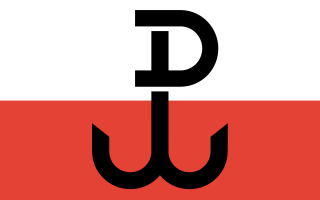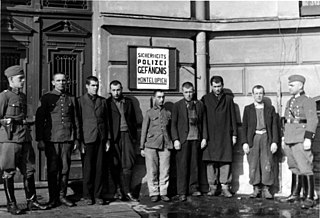
The Home Army was the dominant resistance movement in German-occupied Poland during World War II. The Home Army was formed in February 1942 from the earlier Związek Walki Zbrojnej established in the aftermath of the German and Soviet invasions in September 1939. Over the next two years, the Home Army absorbed most of the other Polish partisans and underground forces. Its allegiance was to the Polish government-in-exile in London, and it constituted the armed wing of what came to be known as the Polish Underground State. Estimates of the Home Army's 1944 strength range between 200,000 and 600,000. The latter number made the Home Army not only Poland's largest underground resistance movement but, along with Soviet and Yugoslav partisans, one of Europe's largest World War II underground movements.

Stefan Paweł Rowecki was a Polish general, journalist and the leader of the Armia Krajowa. He was murdered by the Gestapo in prison on the personal order of Heinrich Himmler.

Around six million Polish citizens are estimated to have perished during World War II. Most were civilians killed by the actions of Nazi Germany, the Soviet Union, the Lithuanian Security Police, as well as the Organization of Ukrainian Nationalists and its offshoots.

The Polish government-in-exile, officially known as the Government of the Republic of Poland in exile, was the government in exile of Poland formed in the aftermath of the Invasion of Poland of September 1939, and the subsequent occupation of Poland by Germany, the Soviet Union, and the Slovak Republic, which brought to an end the Second Polish Republic.

Operation Tempest was a series of uprisings conducted during World War II against occupying German forces by the Polish Home Army, the dominant force in the Polish resistance.

Peasant Battalions was a Polish resistance movement, guerrilla and partisan organisation, during World War II. The organisation was created in mid-1940 by the agrarian political party People's Party and by 1944 was partially integrated with the Armia Krajowa. At its height, in summer 1944 the organisation had 160,000 members.
During World War II, resistance movements operated in German-occupied Europe by a variety of means, ranging from non-cooperation to propaganda, hiding crashed pilots and even to outright warfare and the recapturing of towns. In many countries, resistance movements were sometimes also referred to as The Underground.

In Poland, the resistance movement during World War II was led by the Home Army. The Polish resistance is notable among others for disrupting German supply lines to the Eastern Front, and providing intelligence reports to the British intelligence agencies. It was a part of the Polish Underground State.

Aleksander Krzyżanowskinom de guerre "Wilk" was an artillery colonel of the Polish Army, officer of the Service for Poland's Victory, Union of Armed Struggle, commander of the Vilnius District of the Home Army, political prisoner of the Stalinist period. In 1994 he was posthumously promoted to the rank of brigade general.

The "cursed soldiers" or "indomitable soldiers" were a heterogeneous array of anti-Soviet-imperialist and anti-communist Polish resistance movements formed in the later stages of World War II and in its aftermath by members of the Polish Underground State. The above terms, introduced in the early 1990s, reflect the stance of many of the diehard soldiers.

Stalag VIII-F was a German prisoner-of-war camp for Soviet Red Army and Polish Home Army prisoners during World War II. It was located at the northern end of a Germany Army training area at Lamsdorf, Silesia, just to the north of Stalag VIII-B.

The Montelupich Prison, so called from the street in which it is located, the ulica Montelupich, is a historic prison in Kraków from early 20th century, which was used by the Gestapo in World War II. It is universally recognized as "one of the most terrible Nazi prisons in [occupied] Poland". The Gestapo took over the facility from the German Sicherheitspolizei at the end of March 1941. One of the Nazi officials responsible for overseeing the Montelupich Prison was Ludwig Hahn.

Tadeusz Walenty Pełczyński was a Polish Army major general, intelligence officer and chief of the General Staff's Section II.

The Zamość uprising comprised World War II partisan operations, 1942–1944, by the Polish resistance against Germany's Generalplan-Ost forced expulsion of Poles from the Zamość region (Zamojszczyzna) and the region's colonization by German settlers.

Ryszard Reiff was a Polish politician, lawyer, publicist and resistance fighter. He was a deputy to the Polish parliament (Sejm) during the 1968 Polish political crisis and again during the Martial law in Poland.

Adolf Pilch was a Polish resistance fighter during World War II. He became part of the Polish special forces (cichociemni) trained in the United Kingdom, and was parachuted into occupied Poland on 17 February 1943. There, as a member of the Armia Krajowa Polish resistance, he organized a cavalry partisan unit in the Nowogródek area, and broke through to the Kampinos forest near Warsaw, taking control of this area. At its height of operations his unit consisted of up to 1000 men. Between 3 June 1943 and 17 January 1945 his partisans fought in 235 battles.

The Polish Home Army Museum in Orchard Lake, Michigan is dedicated to the memory of the brave men and women of the Armia Krajowa during World War II. The museum tells the story of the struggle for the freedom and independence of Poland during World War II. On September 1, 1939, without declaring war, the Nazi German Army, Navy, and Air Forces invaded Poland from the north, west and south. Sixteen days later, on September 17, the Soviet Union also attacked Poland from the east. For Europe, the Nazi invasion of Poland marked the beginning of World War II; for Poland, the Soviet invasion also marked the beginning of a 50-year struggle against communism.

Stanisław Witold Aronson is a Polish Jew and an Israeli citizen, as well as a former officer of the Polish Home Army (AK) with a rank of lieutenant colonel. He was also a member of the Kedyw unit, "Kolegium A", of the Warsaw Region of AK, a participant in the Warsaw Uprising of 1944, and a lieutenant colonel of the Israeli Defense Force who took part in the 1947–1949 Palestine war, the Yom Kippur War and the 1982 Lebanon War.

Around 6 million Polish citizens perished during World War II: about one fifth of the entire pre-war population of Poland. Most of them were civilian victims of the war crimes and the crimes against humanity which Nazi Germany and the Soviet Union committed during their occupation of Poland. Approximately half of them were Polish Jews who were killed in The Holocaust. Statistics for Polish casualties during World War II are divergent and contradictory. This article provides a summary of the estimates of Poland's human losses in the war as well as a summary of the causes of them.

The occupation of Poland by Nazi Germany and the Soviet Union during World War II (1939–1945) began with the Invasion of Poland in September 1939, and it was formally concluded with the defeat of Germany by the Allies in May 1945. Throughout the entire course of the occupation, the territory of Poland was divided between Nazi Germany and the Soviet Union (USSR), both of which intended to eradicate Poland's culture and subjugate its people. In the summer-autumn of 1941, the lands which were annexed by the Soviets were overrun by Germany in the course of the initially successful German attack on the USSR. After a few years of fighting, the Red Army drove the German forces out of the USSR and crossed into Poland from the rest of Central and Eastern Europe.



















